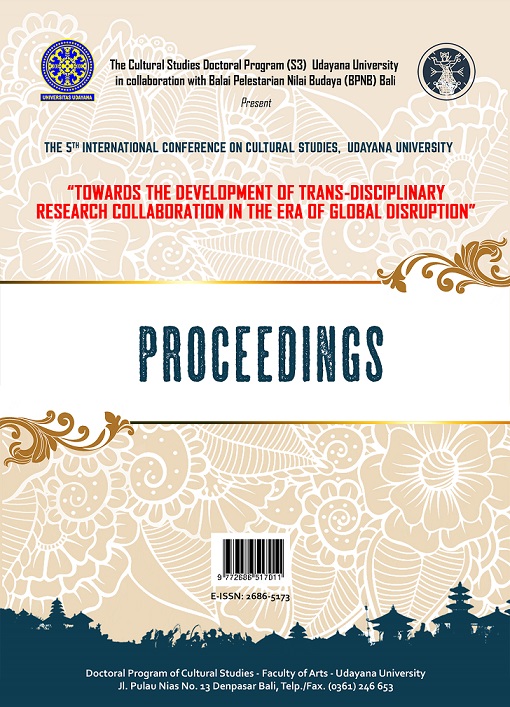MANIFESTATION OF DARK TOURISM INMAKAM RAJA-RAJA MATARAM AT IMOGIRI, DAERAH ISTIMEWA YOGYAKARTA
Abstract
Makam Raja-Raja Mataram (The Kings of Mataram Funeral) in Imogiri D.I Yogyakarta is a Tomb for the Kings of the rulers of Islamic Mataram since its inception until it was divided into Surakarta and Yogyakarta by the Giyanti agreement. Makam Raja-Raja Mataram was founded by the third King of Mataram Islam, Sultan Agung on the Merak Hill for 13 years. After the construction is complete, Sultan Agung dies and is buried there, as well as the Kings thereafter until now. Pajimatan Imogiri is a place that stores tourism potential from the perspective of the Dark Tourism which manifests in various forms, among others: Myths and beliefs which up to now have been trusted by the people of Java and outside Java, the architecture of the Tomb, traditional ceremonies that are thick with mystical atmosphere, applicable regulations, and so forth.
Various myths and beliefs developed in the community regarding the existence of the Pajimatan Imogiri include the holy water stored in each barrel in the grave area, as well as the myth of warriors embedded between the steps leading to the Tombs. Various rituals are often performed here as a tribute to the Spirits of the Kings. Using a variety of prayer and “uba rampe”, “sajen”, “kembang tujuh rupa” and other materials that seem mystical.
This tomb is also guarded directly by Abdi Dalem, the palace of the Kasunanan Surakarta and Kasultanan Yogyakarta. The rules applied are very strict: Prohibited from photographing the Area in the Tombs of the Mataram Kings, It is prohibited to make pilgrimages outside the pilgrimage hours, must wear “kemben” and batik (complete Javanese traditional clothes) when entering the core area of ??the Tomb. With a variety of strict regulations and myths that are thick with mysticism, it makes visitors come from various regions in Indonesia, even many foreign tourists who come because they are interested in the sacredness of the Makam Raja-Raja Mataram.
The building architecture of the Makam Raja-Raja Mataram adopts Hindu, Buddhist and Islamic building styles. Because Sultan Agung is an Islamic figure who highly respects religious tolerance, and at that time was a transition period from the spread of Hindu-Buddhist Religion to Islam in Java. Clearly visible in the building the gate used is an adaptation of the building of a Hindu temple, a system of tomb structures that form Hindu teaching castes, a joglo ward with Buddhist philosophy, and a mosque as a place of Moslem worship.
In addition to the cool atmosphere of the hills and thick Javanese customs felt at the Makam Raja-Raja Mataram (Cemetary of Mataram Kings), there are also various things that are thick with mystical atmosphere when studied further. The potentials manifested at the Makam Raja-Raja Mataram become very strong when viewed from the perception of Dark Tourism.
Downloads
References
Amellia, M. (2013). Simbolisasi Illuminati pada Video Klip Laday Gaga . eJournal Ilmu Komunikasi,.
Ardianto, E. (2010). Metodologi Penelitian untuk Public Relations Kuantitatif dan Kualitatif . Bandung: Simbiosa Rekatama Media .
Ardiwidjaja, R. (2018). Arkeowisata Mengembangkan Daya Tarik Pelestarian Warisan Budaya . Yogyakarta : Deepublish.
Badarab, F., Trihayuningtyas , E., & Suryadana , M. L. (2017 ). Strategi Pengembangan Destinasi Pariwisata di kepulauan Togean provinsi Sulawesi Tengah . Tourism and Hospitality Essentials (THE) Journal, Vol. 7.
Bowman, M. S. (2010). what's so 'dark' about 'Dark Tourism'? : Death, tours and performance . Tourist Studies , 88.
Bungin, B. (2008). Metodologi Penelitian Kualitatif . Jakarta : Raja Grafindo Persada .
Chodijah, L. (2012). Potensi Dark Tourism di Jakarta. Skripsi , 13.
Gita, R. A. (2011). Mata Kuliah Metodologi Penelitian sosial Universitas Brawijaya . Metode Penelitian Kuantitatif & Kualitatif.
Indrawan, R., & Yaniawati , R. P. (2014). Metodologi Penelitian. Bandung : PT Refika Aditama.
Kempa, C. S. (2003). Shades of Dark Tourism Alcatraz and Robben Island. Annals of Tourism Research, 30.
Pitana , I. G., & Gayatri, P. G. (2005). Sosiologi Pariwisata. Yogyakarta : Andi.
Putri, A. E., & dkk. (2018). Pengaruh model active learning tipe practice rehearsal paris terhadap hasil belajar siswa X TKJ dalam mata pelajaran simulasi Digital. Voteknika.
Rahmah, Y. (2017). Museum Fatahillah sebagai Destinasi Utama Dark Tourism di Kawasan kota Tua Jakarta . Makalah Universitas Pendidikan Indonesia Bandung .
Stone, P. R. (2010). Death, Dying and Dark Tourism in contemporary society : A Theoretical and Empirical Analysis. PhD Thesis .
Stone, P. R. (2012). Dark Tourism and significant other death toward a model of mortality mediation . Annals of Tourism Research, Vol. 39.
Sudrajad, A. w. (2018). Sejarah Penaklukan Jawa. Yogyakarta: Society.
Sutardi, T. (2007). Antropologi : Mengungkap Keragaman Budaya . Bandung : PT. Setia Purna Inves .





